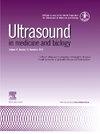用于牙周软组织特征描述的定量超声。
IF 2.4
3区 医学
Q2 ACOUSTICS
引用次数: 0
摘要
目的:牙周病是一系列炎症性疾病,在美国,45.9% 年龄≥30 岁的成年人患有牙周病。目前,诊所评估口腔软组织炎症的标准是探诊出血,这是一种侵入性、主观性和半定性的方法。定量超声(QUS)在对各种软组织进行非侵入性定量表征方面取得了可喜的成果,但尚未应用于临床牙周病学。研究对象包括在四个口腔象限扫描的 10 头猪,共扫描 40 次。基于 QUS 的斑点建模采用了 Burr 和 Nakagami 两参数模型。这些参数的参数成像也是使用在单独的模型研究中估算出的最佳窗口大小创建的:结果:模型结果表明,10 个波长的窗口大小是合理的估计内核。牙龈的Burr幂律参数和Nakagami形状因子均高于牙槽粘膜,而牙龈的Burr和Nakagami比例因子均低于牙槽粘膜。两种组织类型之间的差异具有统计学意义(P < 0.0001)。使用 Burr 和 Nakagami 模型的二维参数空间对这两种组织类型进行线性分类,其分割准确率分别为 93.51% 和 90.91%。组织学染色图像的结果显示,牙龈和牙槽粘膜具有不同的底层结构,牙龈的染色更浓:QUS结果表明,牙龈和牙槽粘膜可通过Burr和Nakagami参数进行区分。我们认为 QUS 具有描述牙周软组织特征的巨大潜力,可以成为牙周病学和种植牙学的客观定量诊断工具,从而改善牙齿保健。本文章由计算机程序翻译,如有差异,请以英文原文为准。
Quantitative Ultrasound for Periodontal Soft Tissue Characterization
Objective
Periodontal diseases are a spectrum of inflammatory diseases that affect 45.9% of adults aged ≥30 years in the United States Current standard of care in clinics for the assessment of oral soft tissue inflammation is bleeding on probing,which is invasive, subjective and semi-qualitative. Quantitative ultrasound (QUS) has shown promising results in the non-invasive quantitative characterization of various soft tissues; however, it has not been used in clinical periodontics.
Methods
Here, we investigated the QUS analysis of two periodontal soft tissues (alveolar mucosa and gingiva) in vivo. The study cohort included 10 swine scanned at four oral quadrants, resulting in 40 scans. Two-parameter Burr and Nakagami models were employed for QUS-based speckle modeling. Parametric imaging of these parameters was also created using an optimal window size estimated in a separate phantom study.
Results
Phantom results suggested a window size of 10 wavelengths as the reasonable estimation kernel. The Burr power-law parameter and Nakagami shape factor were higher in gingiva than alveolar mucosa, while Burr and Nakagami scale factors were both lower in the gingiva. The difference between the two tissue types was statistically significant (p < 0.0001). Linear classifications of these two tissue types using a 2-D parameter space of the Burr and Nakagami models resulted in a segmentation accuracy of 93.51% and 90.91%, respectively. Findings from histology-stained images showed that gingiva and alveolar mucosa had distinct underlying structures, with the gingiva showing a denser stain.
Conclusion
QUS results suggest that gingiva and alveolar mucosa can be differentiated using Burr and Nakagami parameters. We propose that QUS holds promising potential for the characterization of periodontal soft tissues and could become an objective and quantitative diagnostic tool for periodontology and implant dentistry to improve dental health care.
求助全文
通过发布文献求助,成功后即可免费获取论文全文。
去求助
来源期刊
CiteScore
6.20
自引率
6.90%
发文量
325
审稿时长
70 days
期刊介绍:
Ultrasound in Medicine and Biology is the official journal of the World Federation for Ultrasound in Medicine and Biology. The journal publishes original contributions that demonstrate a novel application of an existing ultrasound technology in clinical diagnostic, interventional and therapeutic applications, new and improved clinical techniques, the physics, engineering and technology of ultrasound in medicine and biology, and the interactions between ultrasound and biological systems, including bioeffects. Papers that simply utilize standard diagnostic ultrasound as a measuring tool will be considered out of scope. Extended critical reviews of subjects of contemporary interest in the field are also published, in addition to occasional editorial articles, clinical and technical notes, book reviews, letters to the editor and a calendar of forthcoming meetings. It is the aim of the journal fully to meet the information and publication requirements of the clinicians, scientists, engineers and other professionals who constitute the biomedical ultrasonic community.

 求助内容:
求助内容: 应助结果提醒方式:
应助结果提醒方式:


